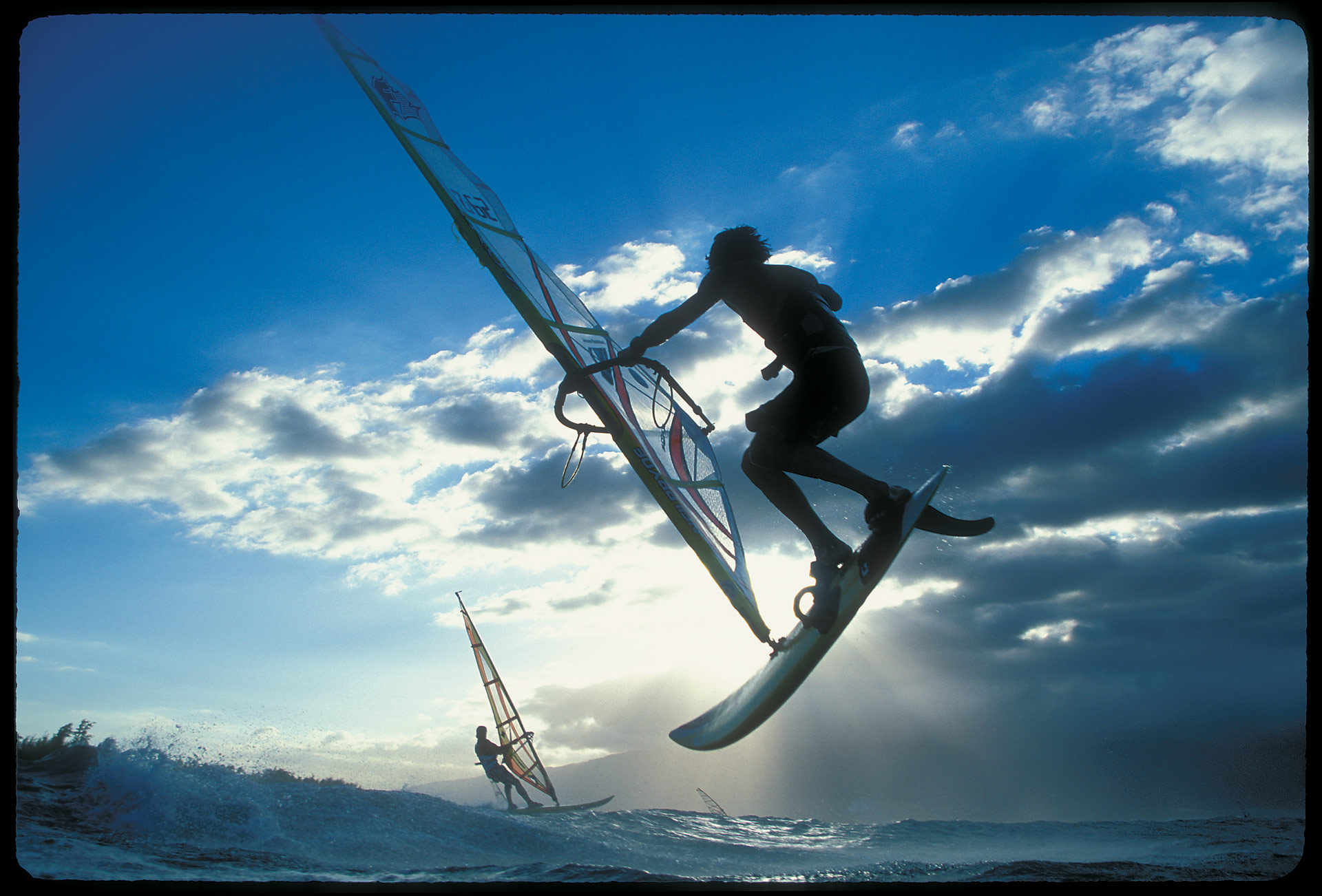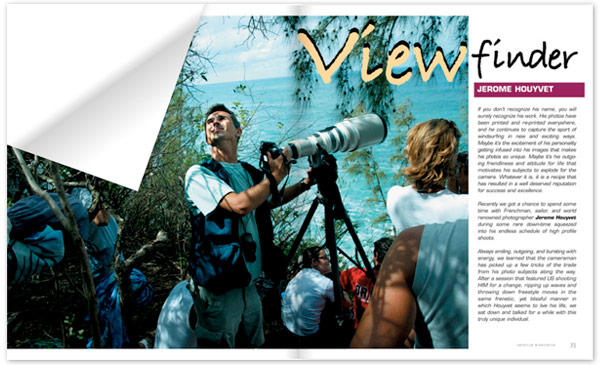
HIS PHOTOS have been printed and reprinted everywhere, and he continues to capture the sport of windsurfing in new and exciting ways. Maybe it’s the excitement of his personality getting infused into his images that make his photos so unique. Maybe it’s his outgoing friendliness and attitude for life that motivates his subjects to explode for the camera. Whatever it is, it is a recipe that has resulted in a well-deserved reputation for success and excellence.
Recently we got a chance to spend some time with Frenchman, sailor, and world renowned photographer Jerome Houyvet during some rare downtime squeezed into his endless schedule of high profile shoots.
Always smiling, outgoing, and bursting with energy, we learned that the cameraman has picked up a few tricks of the trade from his photo subjects along the way. After a session that featured US shooting HIM for a change, ripping up waves and throwing down freestyle moves in the same frenetic, yet the blissful manner in which Houyvet seems to live his life, we sat down and talked for a while with this truly unique individual.
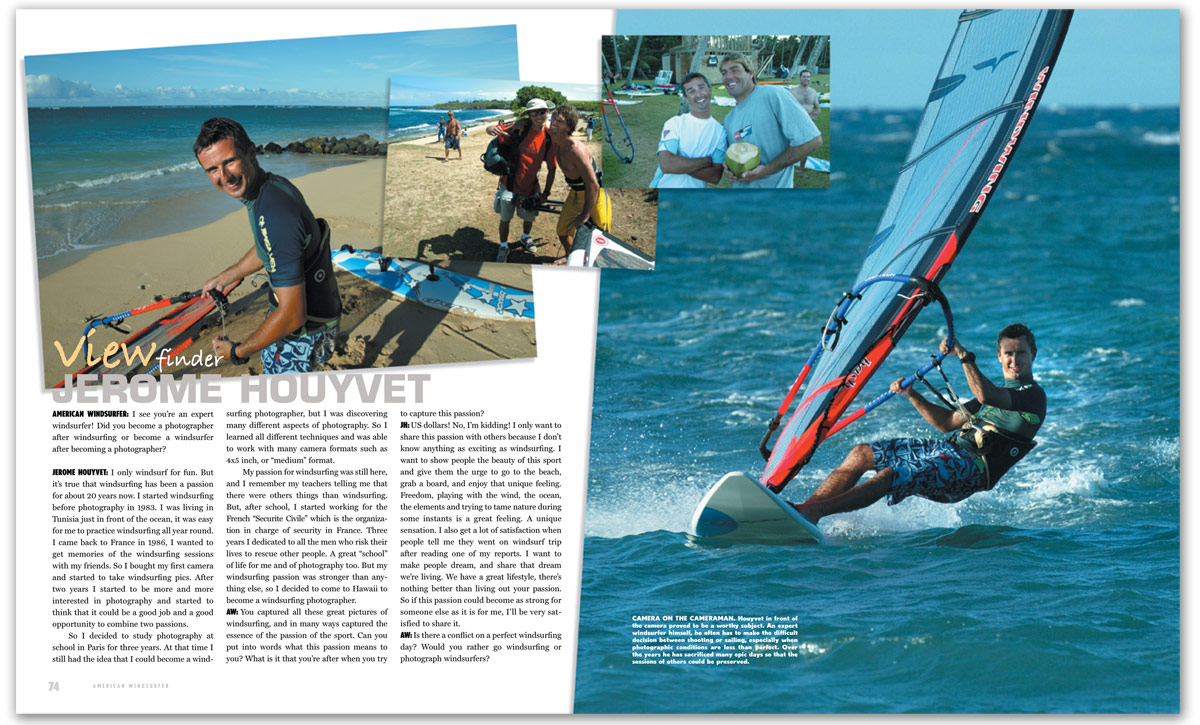
CAMERA ON THE CAMERAMAN. Houyvet in front of the camera proved to be a worthy subject. An expert windsurfer himself, he often has to make the difficult decision between shooting or sailing, especially when photographic conditions are less than perfect. Over the years he has sacrificed many epic days so that the sessions of others could be preserved.
AMERICAN WINDSURFER: I see you’re an expert windsurfer! Did you become a photographer after windsurfing or become a windsurfer after becoming a photographer?
JEROME HOUYVET: I only windsurf for fun. But it’s true that windsurfing has been a passion for about 20 years now. I started windsurfing before photography in 1983. I was living in Tunisia just in front of the ocean, it was easy for me to practice windsurfing all year round. I came back to France in 1986, I wanted to get memories of the windsurfing sessions with my friends. So I bought my first camera and started to take windsurfing pics. After two years I started to be more and more interested in photography and started to think that it could be a good job and a good opportunity to combine two passions.
So I decided to study photography at a school in Paris for three years. At that time, I still had the idea that I could become a windsurfing photographer, but I was discovering many different aspects of photography. So I learned all different techniques and was able to work with many camera formats such as 4×5 inch, or “medium” format.
My passion for windsurfing was still here, and I remember my teachers telling me that there were others things than windsurfing. But, after school, I started working for the French “Securite Civile” which is the organization in charge of security in France. Three years I dedicated to all the men who risk their lives to rescue other people. A great “school” of life for me and of photography too. But my windsurfing passion was stronger than anything else, so I decided to come to Hawaii to become a windsurfing photographer.
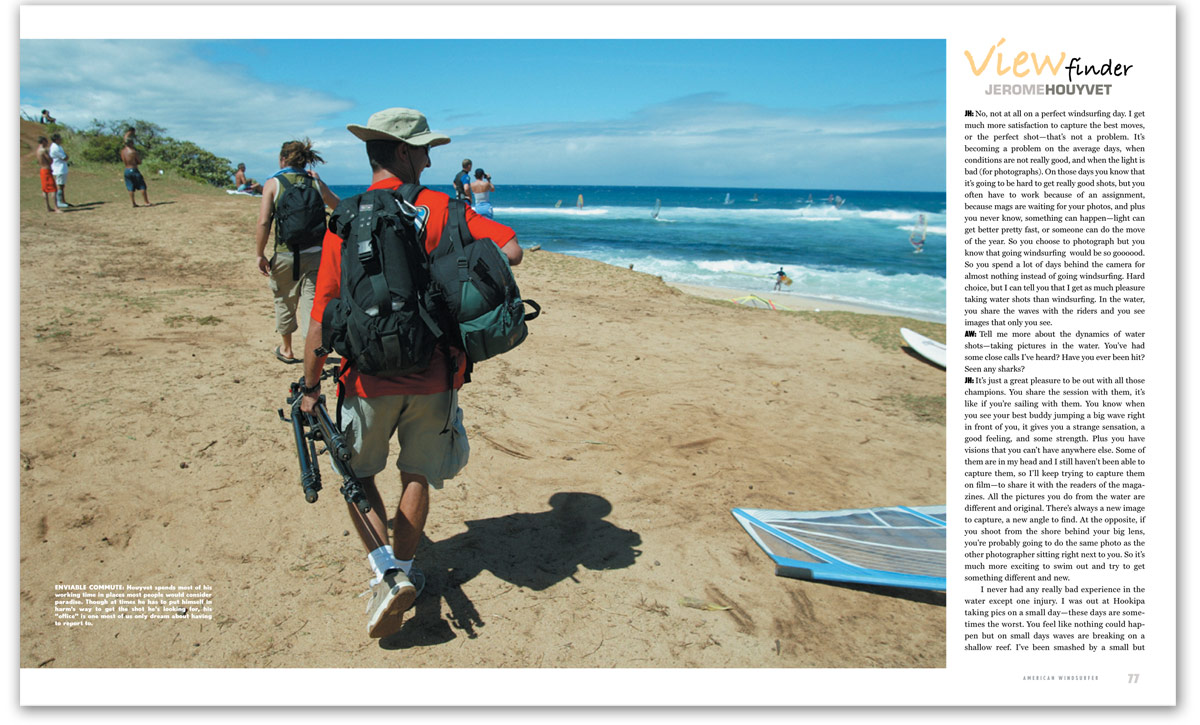
ENVIABLE COMMUTE: Houyvet spends most of his working time in places most people would consider paradise. Though at times he has to put himself in harm’s way to get the shot he’s looking for, his “office” is one most of us only dream about having to report to.
AW: You captured all these great pictures of windsurfing, and in many ways captured the essence of the passion of the sport. Can you put into words what this passion means to you? What is it that you’re after when you try to capture this passion?
JH: US dollars! No, I’m kidding! I only want to share this passion with others because I don’t know anything as exciting as windsurfing. I want to show people the beauty of this sport and give them the urge to go to the beach, grab a board, and enjoy that unique feeling. Freedom, playing with the wind, the ocean, the elements and trying to tame nature during some instants is a great feeling. A unique sensation. I also get a lot of satisfaction when people tell me they went on windsurf trip after reading one of my reports. I want to make people dream, and share that dream we’re living. We have a great lifestyle, there’s nothing better than living out your passion. So if this passion could become as strong for someone else as it is for me, I’ll be very satisfied to share it.
AW: Is there a conflict on a perfect windsurfing day? Would you rather go windsurfing or photograph windsurfers?
JH: No, not at all on a perfect windsurfing day. I get much more satisfaction to capture the best moves, or the perfect shot—that’s not a problem. It’s becoming a problem on the average days when conditions are not really good, and when the light is bad (for photographs). On those days you know that it’s going to be hard to get really good shots, but you often have to work because of an assignment, because mags are waiting for your photos, and plus you never know, something can happen—light can get better pretty fast, or someone can do the move of the year. So you choose to photograph but you know that going windsurfing would be so goooood. So you spend a lot of days behind the camera for almost nothing instead of going windsurfing. Hard choice, but I can tell you that I get as much pleasure taking water shots than windsurfing. In the water, you share the waves with the riders and you see images that only you see.
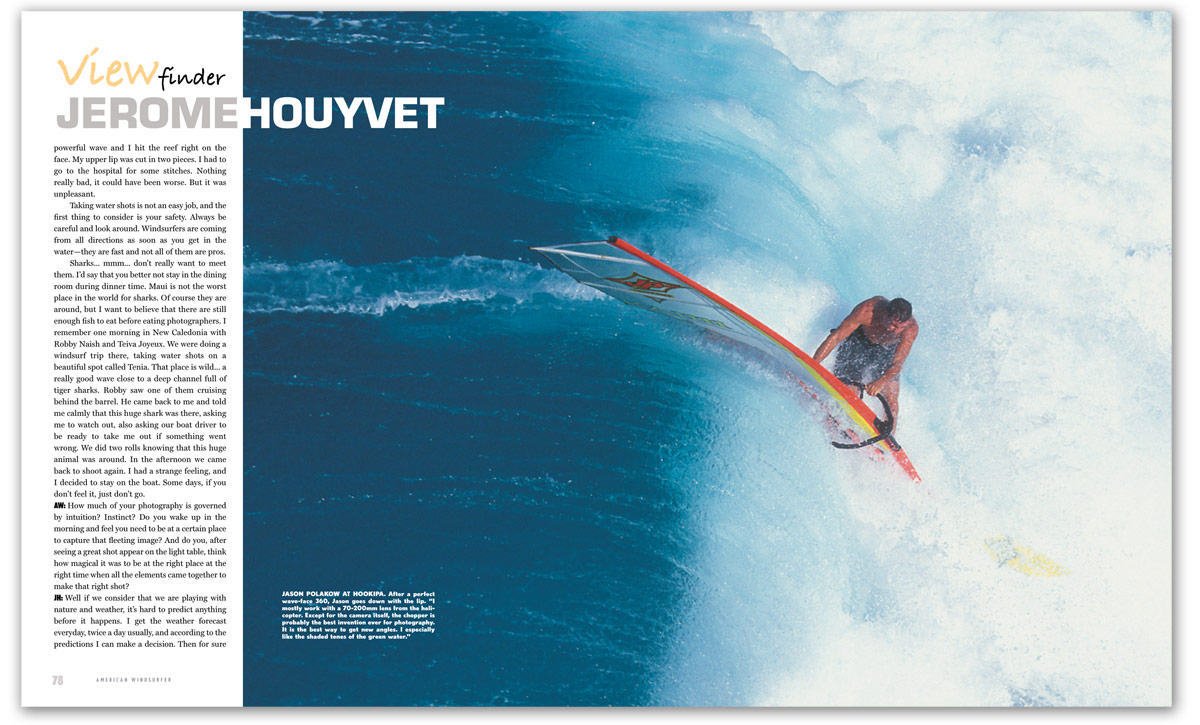
JASON POLAKOW at Hookipa. After a perfect wave-face 360, Jason goes down with the lip. “I mostly work with a 70-200mm lens from the helicopter. Except for the camera itself, the chopper is probably the best invention ever for photography. It is the best way to get new angles. I especially like the shaded tones of the green water.”
AW: Tell me more about the dynamics of water shots—taking pictures in the water. You’ve had some close calls I’ve heard? Have you ever been hit? Seen any sharks?
JH: It’s just a great pleasure to be out with all those champions. You share the session with them, it’s like if you’re sailing with them. You know when you see your best buddy jumping a big wave right in front of you, it gives you a strange sensation, a good feeling, and some strength. Plus you have visions that you can’t have anywhere else. Some of them are in my head and I still haven’t been able to capture them, so I’ll keep trying to capture them on film—to share it with the readers of the magazines. All the pictures you do from the water are different and original. There’s always a new image to capture, a new angle to find. At the opposite, if you shoot from the shore behind your big lens, you’re probably going to do the same photo as the other photographer sitting right next to you. So it’s much more exciting to swim out and try to get something different and new.
I never had any really bad experience in the water except one injury. I was out at Hookipa taking pics on a small day—these days are sometimes the worst. You feel like nothing could happen but on small days, waves are breaking on a shallow reef. I’ve been smashed by a small but powerful wave and I hit the reef right in the face. My upper lip was cut in two pieces. I had to go to the hospital for some stitches. Nothing really bad, it could have been worse. But it was unpleasant.
Taking water shots is not an easy job, and the first thing to consider is your safety. Always be careful and look around. Windsurfers are coming from all directions as soon as you get in the water—they are fast and not all of them are pros.
Sharks… mmm… don’t really want to meet them. I’d say that you better not stay in the dining room during dinner time. Maui is not the worst place in the world for sharks. Of course, they are around, but I want to believe that there are still enough fish to eat before eating photographers. I remember one morning in New Caledonia with Robby Naish and Teiva Joyeux. We were doing a windsurf trip there, taking water shots on a beautiful spot called Tenia. That place is wild… a really good wave close to a deep channel full of tiger sharks. Robby saw one of them cruising behind the barrel. He came back to me and told me calmly that this huge shark was there, asking me to watch out, also asking our boat driver to be ready to take me out if something went wrong. We did two rolls knowing that this huge animal was around. In the afternoon, we came back to shoot again. I had a strange feeling, and I decided to stay on the boat. Some days, if you don’t feel it, just don’t go.
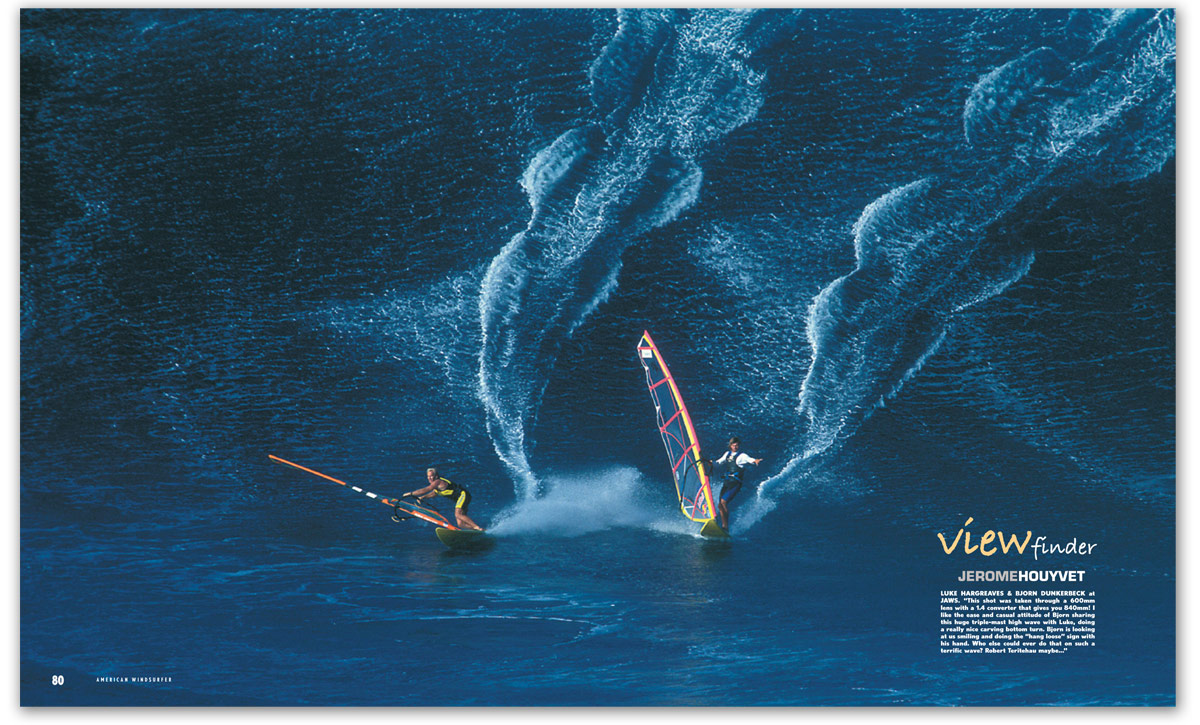
LUKE HARGREAVES & BJORN DUNKERBECK at JAWS. “This shot was taken through a 600mm lens with a 1.4 converter that gives you 840mm! I like the ease and casual attitude of Bjorn sharing this huge triple-mast high wave with Luke, doing a really nice carving bottom turn. Bjorn is looking at us smiling and doing the “hang loose” sign with his hand. Who else could ever do that on such a terrific wave? Robert Teritehau maybe…”
AW: How much of your photography is governed by intuition? Instinct? Do you wake up in the morning and feel you need to be at a certain place to capture that fleeting image? And do you, after seeing a great shot appear on the light table, think how magical it was to be at the right place at the right time when all the elements came together to make that right shot?
JH: Well if we consider that we are playing with nature and weather, it’s hard to predict anything before it happens. I get the weather forecast every day, twice a day usually, and according to the predictions, I can make a decision. Then for sure instinct takes part of the choice and more in Maui where the weather changes faster than anywhere else. Even on the beach, you have to evaluate how things could turn. You don’t know if the wind is going to die, or the swell will build. Nobody really knows how the day will be, so you follow your instinct and decide to stay or change. When I wake up, after checking the forecast, I also watch the sky and often go to the beach to check the swell direction and size. Then I have an idea of what’s going to happen, sometimes nothing at all. Or then I might feel that it’s going to be a good day on the light table to watch and select my last photos.
It can be a great pleasure when you discover the pics on the light table, especially on one of those very bad days. But when things turn good, light is great, the action is perfect… Wa ou UW… YES! What a great feeling. You forget instantly all efforts and time you had to wait for this perfect day.
AW: When you edit your film, what are you looking for? Describe the process of picking pictures that get you excited?
JH: First thing is to check the sharpness and exposure. The slide is going directly to the trash if those two points are not all right. Quality of the light of course, then action is the point. I like those shots where you see the face of the rider, his expression. If by chance you see his face and the action is great—you have a good shot. I get more excited if the photo seems to be different from what I’ve seen before, with different backgrounds or different techniques.
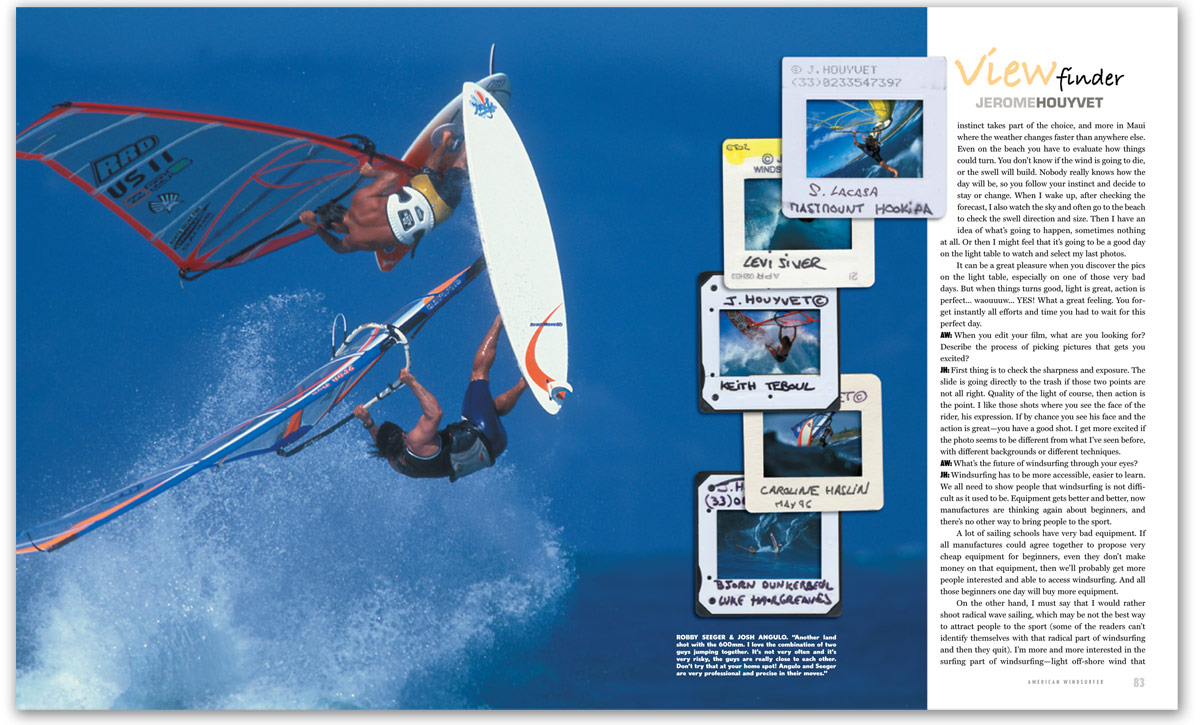
ROBBY SEEGER & JOSH ANGULO. “Another land shot with the 600mm. I love the combination of two guys jumping together. It’s not very often and it’s very risky, the guys are really close to each other. Don’t try that at your home spot! Angulo and Seeger are very professional and precise in their moves.”
AW: What’s the future of windsurfing through your eyes?
JH: Windsurfing has to be more accessible, easier to learn. We all need to show people that windsurfing is not difficult as it used to be. Equipment gets better and better, now manufactures are thinking again about beginners, and there’s no other way to bring people to the sport.
A lot of sailing schools have very bad equipment. If all manufactures could agree together to propose very cheap equipment for beginners, even they don’t make money on that equipment, then we’ll probably get more people interested and able to access windsurfing. And all those beginners one day will buy more equipment.
On the other hand, I must say that I would rather shoot radical wave sailing, which may be not the best way to attract people to the sport (some of the readers can’t identify themselves with that radical part of windsurfing and then they quit). I’m more and more interested in the surfing part of windsurfing—light off-shore wind that makes the waves look glassy and perfect. I’m looking for that perfection you can only see in the surfing magazines—and it gets more exciting if it’s radical if the human performance is better. The image gets intense, especially if you can see the facial expression of the rider.
AW: Do you think the radical side of windsurfing has killed the sport?
JH: Yes, it is probably one reason between others. As windsurfing became radical, manufacturers started to offer more and more radical equipment and they simply forgot the beginners. As the magazines did too—the boards were less and less accessible—as was the image of the sport too. Remember at the beginning windsurfing was a “family sport”, you could learn windsurfing at almost every age, and all the family could try. Then those small boards came and the sport began to be less accessible, but it also gets more and more exciting— and expensive.
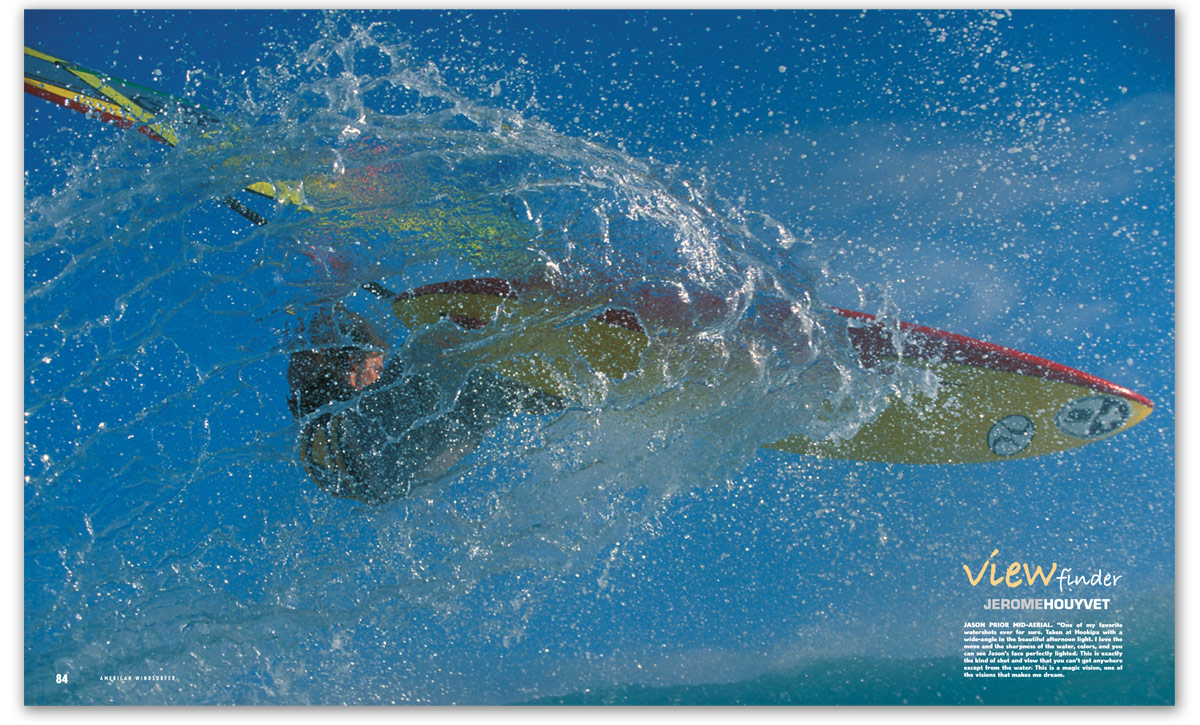
JASON PRIOR mid-aerial. “One of my favorite watershots ever for sure. Taken at Hookipa with a wide-angle in the beautiful afternoon light. I love the move and the sharpness of the water, colors, and you can see Jason’s face perfectly lighted. This is exactly the kind of shot and view that you can’t get anywhere except from the water. This is a magic vision, one of the visions that makes me dream.
AW: Forgive me, but do you ever blame yourself for contributing to this direction by doing too good of a job showing the radical side of the sport? How can you blame the manufacturers for forgetting the beginners when the human tendency is to follow the excitement?
JH: No, not really. As I said before, I’d rather shoot radical windsurfing, that’s for sure. I know there’s a contradiction with what I’ve said before but I’m not here to save the sport. We need people doing that part of the job. And we also need those radical images. Note that I also shoot freeride windsurfing, I even edited large posters of a freeride this year.
About the manufacturers, I don’t think they’re following the excitement due to the radical part of the sport, they’re not here for the poetry. They need to make money to survive. That’s all. They only follow the tendency. And I really think they’re acting much better than they used to do ten years ago. They all know now that they need to offer more accessible equipment. The effort should be now on the price of this equipment for beginners.
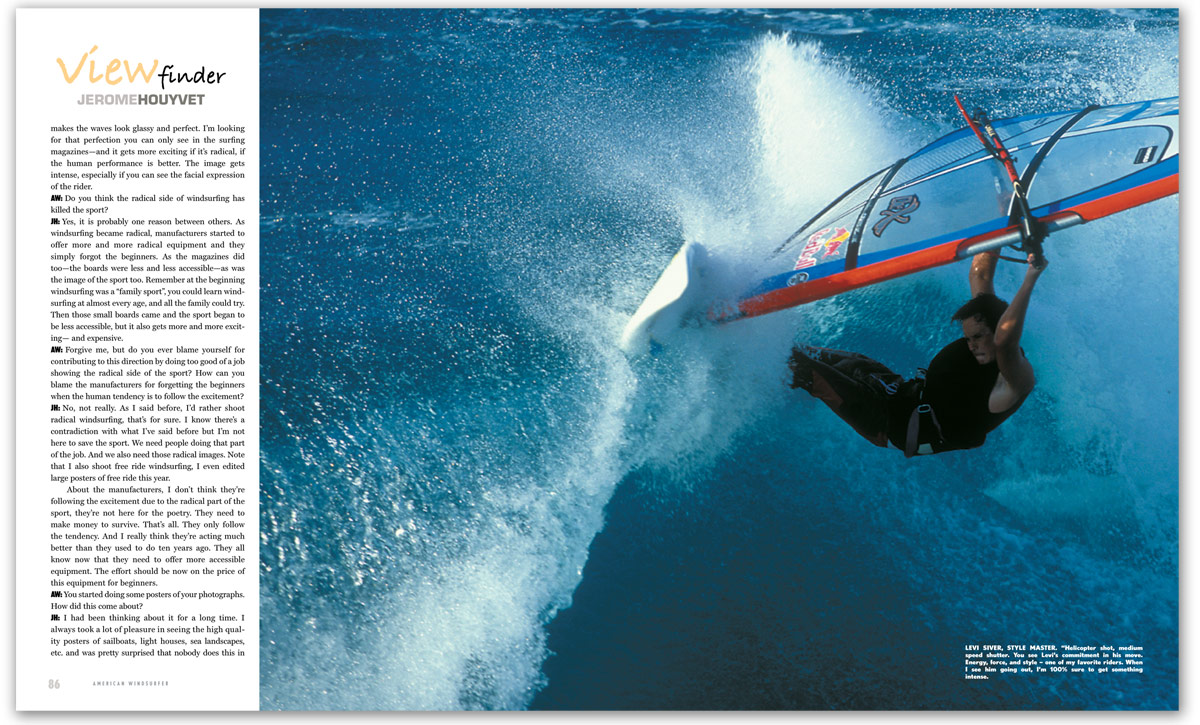
LEVI SIVER, style MASTER. “Helicopter shot, medium speed shutter. You see Levi’s commitment in his move. Energy, force, and style – one of my favorite riders. When I see him going out, I’m 100% sure to get something intense.
AW: You started doing some posters of your photographs. How did this come about?
JH: I had been thinking about it for a long time. I always took a lot of pleasure in seeing the high quality posters of sailboats, light houses, sea landscapes, etc. and was pretty surprised that nobody does this in windsurfing. I wanted to do something that I could entirely control, from the beginning to the end-–the photo, the lay out, the choice of paper, of printery–something that you never do when you work with the press, or the manufacturers.
It took me a few years to decide to start the Windsurf gallery collection. I must say that it was a big investment of time and money, for an uncertain result. But, I had this in my mind and I did it for the pleasure first. Publishing your own photos on large size paper is the best thing to do for a photographer. So I started with four models last year, and I just added five new models. I had to build my website (www.windsurfgallery.com) and that was pretty exciting too. It’s a good way to share this passion for windsurfing and photography. I receive a lot of kind messages from all over the world. Its simply great!
AW: What do you look for when you try to decide which picture to pick for a poster.
JH: Choosing a picture for a poster is very difficult. As with all the other photos I choose, it has to be perfectly sharp and well exposed of course. This is not the difficult part. No, the main thing is to find the photo that people will want to have in their room or office. A photo that will make people dream–and that’s not easy when you consider all the different opinions. I usually make a first selection of very very few shots and then I ask opinions around, but I usually make my choice first and then it’s hard to make me change. New Caledonia and Virgin islands panoramic posters have a large success–so it looks like those were good choices.
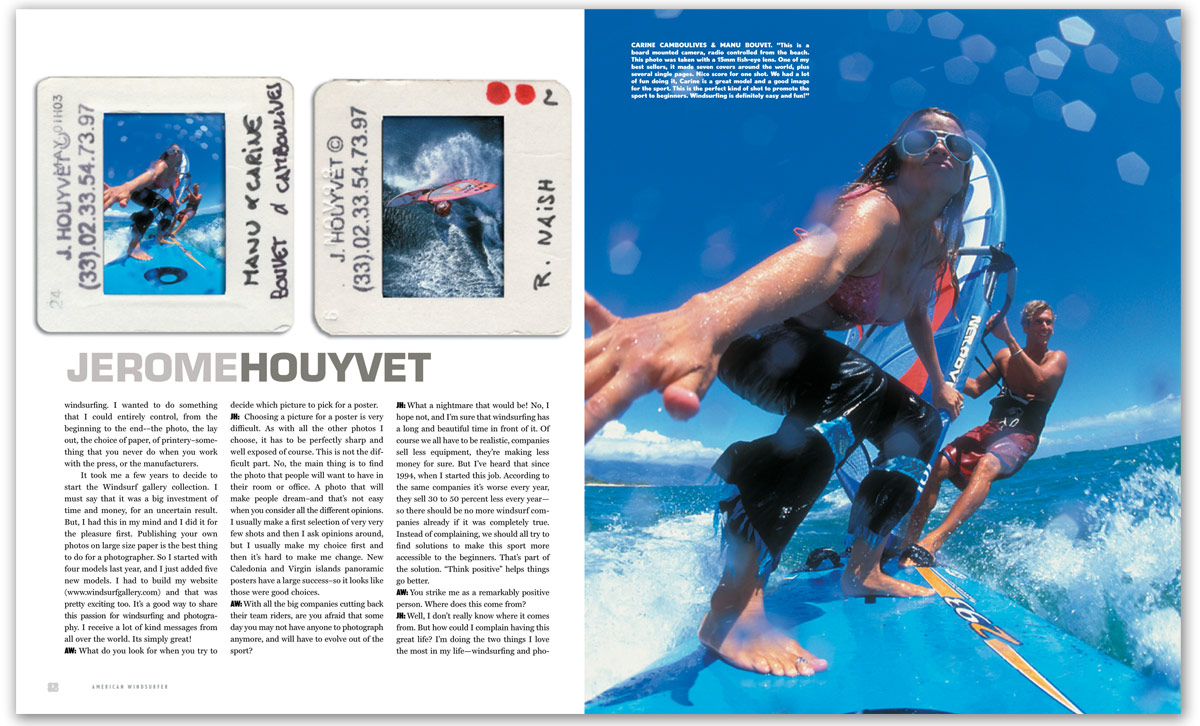
CARINE CAMBOULIVES & MANU BOUVET. “This is a board mounted camera, radio controlled from the beach. This photo was taken with a 15mm fish-eye lens. One of my best sellers, it made seven covers around the world, plus several single pages. Nice score for one shot. We had a lot of fun doing it, Carine is a great model and a good image for the sport. This is the perfect kind of shot to promote the sport to beginners. Windsurfing is definitely easy and fun!”
AW: With all the big companies cutting back their team riders, are you afraid that some day you may not have anyone to photograph anymore, and will have to evolve out of the sport?
JH: What a nightmare that would be! No, I hope not, and I’m sure that windsurfing has a long and beautiful time in front of it. Of course we all have to be realistic, companies sell less equipment, they’re making less money for sure. But I’ve heard that since 1994, when I started this job. According to the same companies it’s worse every year, they sell 30 to 50 percent less every year—so there should be no more windsurf companies already if it was completely true. Instead of complaining, we should all try to find solutions to make this sport more accessible to the beginners. That’s part of the solution. “Think positive” helps things go better.
AW: You strike me as a remarkably positive person. Where does this come from?
JH: Well, I don’t really know where it comes from. But how could I complain having this great life? I’m doing the two things I love the most in my life—windsurfing and photography. These are my two passions, and I have managed to combine both of them to make a living. How many people do you know around you that have the chance to live off their passions? I hate people who constantly complain about their poor existence after doing windsurfing all day long, and I meet people like this. In that case, I want to say, “Hey! Look at the world around you, wake up! You’re not sick, you eat well and you windsurf almost everyday.” As long as I’ll be in good health and able to do what I do now, I should never complain and always stay positive. In respect to the ones who don’t have this chance.
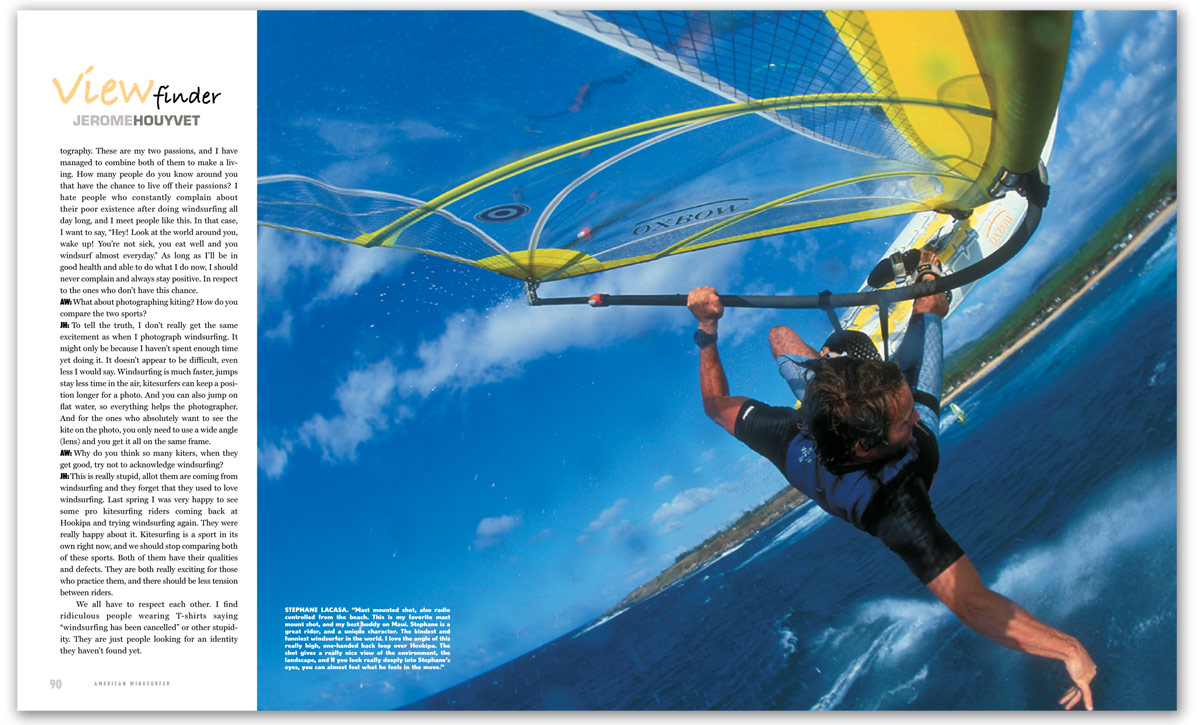
STEPHANE LACASA. “Mast mounted shot, also radio controlled from the beach. This is my favorite mast mount shot, and my best buddy on Maui. Stephane is a great rider, and a unique character. The kindest and funniest windsurfer in the world. I love the angle of this really high, one-handed back loop over Hookipa. The shot gives a really nice view of the environment, the landscape, and if you look really deeply into Stephane’s eyes, you can almost feel what he feels in the move.”
AW: What about photographing kiting? How do you compare the two sports?
JH: To tell the truth, I don’t really get the same excitement as when I photograph windsurfing. It might only be because I haven’t spent enough time yet doing it. It doesn’t appear to be difficult, even less I would say. Windsurfing is much faster, jumps stay less time in the air, kitesurfers can keep a position longer for a photo. And you can also jump on flat water, so everything helps the photographer. And for the ones who absolutely want to see the kite on the photo, you only need to use a wide angle (lens) and you get it all on the same frame.
AW: Why do you think so many kiters, when they get good, try not to acknowledge windsurfing?
JH: This is really stupid, allot them are coming from windsurfing and they forget that they used to love windsurfing. Last spring I was very happy to see some pro kitesurfing riders coming back at Hookipa and trying windsurfing again. They were really happy about it. Kitesurfing is a sport in its own right now, and we should stop comparing both of these sports. Both of them have their qualities and defects. They are both really exciting for those who practice them, and there should be less tension between riders.
We all have to respect each other. I find ridiculous people wearing T-shirts saying “windsurfing has been cancelled” or other stupidity. They are just people looking for an identity they haven’t found yet.
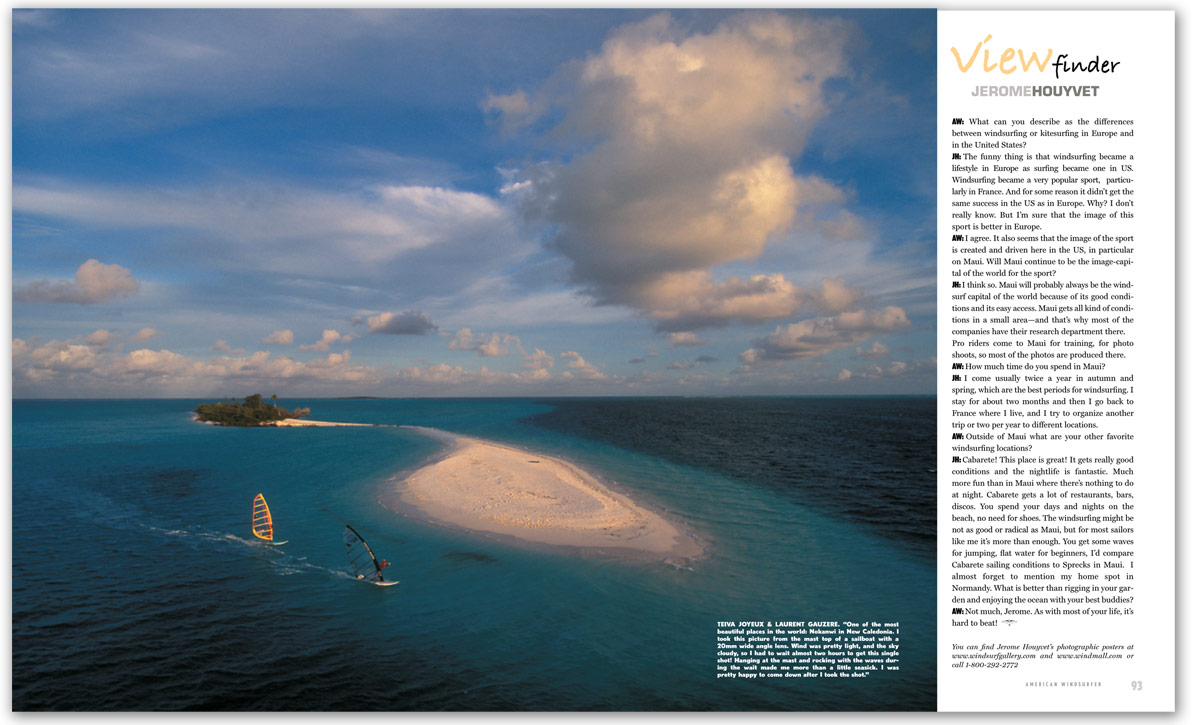
TEIVA JOYEUX & LAURENT GAUZERE. “One of the most beautiful places in the world: Nokanwi in New Caledonia. I took this picture from the mast top of a sailboat with a 20mm wide angle lens. Wind was pretty light, and the sky cloudy, so I had to wait almost two hours to get this single shot! Hanging at the mast and rocking with the waves during the wait made me more than a little seasick. I was pretty happy to come down after I took the shot.”
AW: What can you describe as the differences between windsurfing or kitesurfing in Europe and in the United States?
JH: The funny thing is that windsurfing became a lifestyle in Europe as surfing became one in US. Windsurfing became a very popular sport, particularly in France. And for some reason it didn’t get the same success in the US as in Europe. Why? I don’t really know. But I’m sure that the image of this sport is better in Europe.
AW: I agree. It also seems that the image of the sport is created and driven here in the US, in particular on Maui. Will Maui continue to be the image-capital of the world for the sport?
JH: I think so. Maui will probably always be the windsurf capital of the world because of its good conditions and its easy access. Maui gets all kind of conditions in a small area—and that’s why most of the companies have their research department there.
Pro riders come to Maui for training, for photo shoots, so most of the photos are produced there.
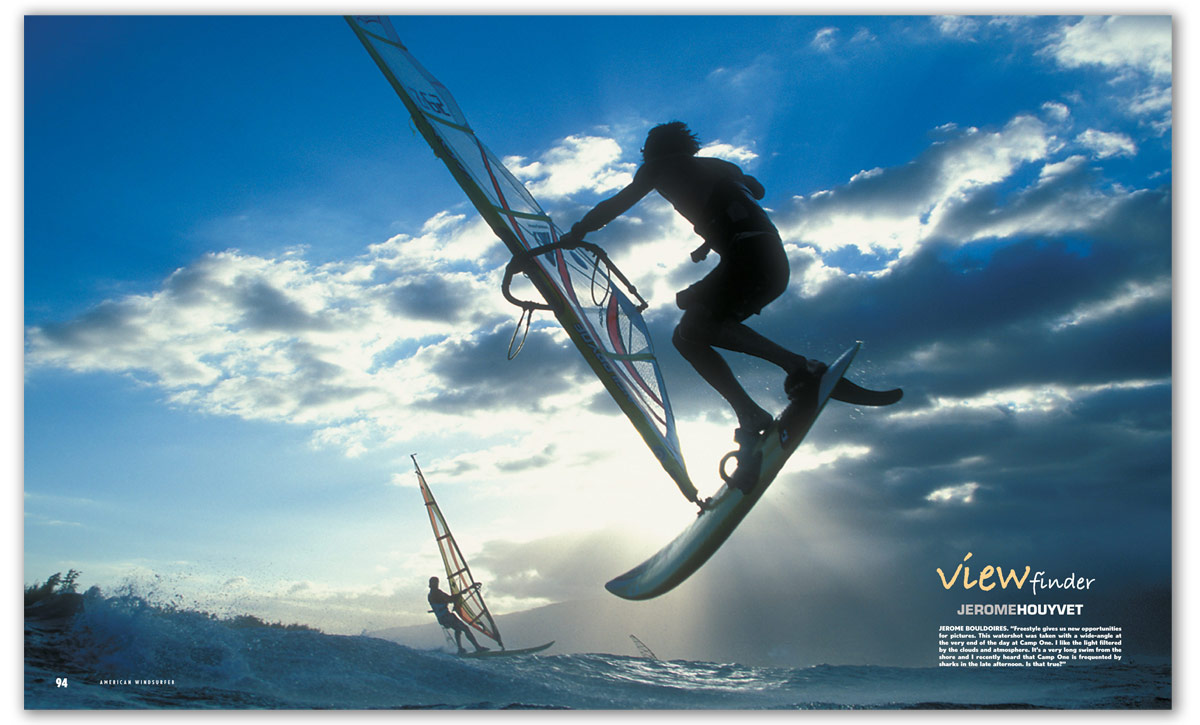
JEROME BOULDOIRES. “Freestyle gives us new opportunities for pictures. This watershot was taken with a wide-angle at the very end of the day at Camp One. I like the light filtered by the clouds and atmosphere. It’s a very long swim from the shore and I recently heard that Camp One is frequented by sharks in the late afternoon. Is that true?”
AW: How much time do you spend in Maui?
JH: I come usually twice a year in autumn and spring, which are the best periods for windsurfing. I stay for about two months and then I go back to France where I live, and I try to organize another trip or two per year to different locations.
AW: Outside of Maui what are your other favorite windsurfing locations?
JH: Cabarete! This place is great! It gets really good conditions and the nightlife is fantastic. Much more fun than in Maui where there’s nothing to do at night. Cabarete gets a lot of restaurants, bars, discos. You spend your days and nights on the beach, no need for shoes. The windsurfing might be not as good or radical as Maui, but for most sailors like me it’s more than enough. You get some waves for jumping, flat water for beginners, I’d compare Cabarete sailing conditions to Sprecks in Maui. I almost forget to mention my home spot in Normandy. What is better than rigging in your garden and enjoying the ocean with your best buddies?
AW: Not much, Jerome. As with most of your life, it’s hard to beat!
You can find Jerome Houyvet’s photographic posters at www.windsurfgallery.com and www.windmall.com or call 1-800-292-2772


